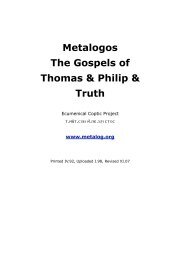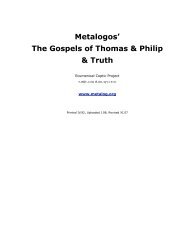Andrew Louth - Syriac Christian Church
Andrew Louth - Syriac Christian Church
Andrew Louth - Syriac Christian Church
Create successful ePaper yourself
Turn your PDF publications into a flip-book with our unique Google optimized e-Paper software.
44 INTRODUCTION<br />
necessity of ascetic struggle, if we are to make any progress towards<br />
God.<br />
In this Difficulty, and elsewhere, there is another more general<br />
difference from the presentation of ascetic theology found in the<br />
earlier works. We have already noted that Evagrius, and following him<br />
Maximus, develops a classification of the passions based on a broadly<br />
Platonic analysis of the make-up of the human soul. At several points<br />
in Difficulty 10, we find Maximus developing a quite elaborate<br />
analysis of the soul, its manner of operation and its relation to the<br />
body. He prefaces his extended treatment of the Transfiguration and<br />
all that in the Old Testament foreshadowed that occasion with an<br />
analysis of the way the soul operates (Amb. 10.2–3). Later on there is<br />
a detailed analysis of the passionate part of the soul (Amb. 10.44).<br />
Both these analyses are drawn, quite directly, from a work by<br />
Nemesius, fourth-century Bishop of Emesa, called On human nature.<br />
As we saw earlier, the point of such analysis is diagnostic: an<br />
understanding of how the soul is affected by the passions will help in<br />
overcoming, or sublimating, them. The source of this analysis in<br />
Evagrius and the early Maximus is mainly a kind of practical wisdom<br />
worked out by the Desert Fathers and their successors (though we<br />
have already noticed some philosophical borrowing); in the Ambigua<br />
(and also in several of the opuscula) such analysis is drawn from the<br />
Greek philosophical tradition (especially from Nemesius, who seems<br />
to have been something of a favourite with Maximus, and later with<br />
St John Damascene). Such a drawing together of ascetic wisdom and<br />
the inheritance of Classical and Hellenistic philosophy is also<br />
something that, through Maximus, becomes characteristic of later<br />
Byzantine theology.<br />
Difficulty 10 presents the most extended discussion of Maximian<br />
theology in a single treatise, covering as it does Trinitarian theology<br />
and Christology, the doctrine of creation and providence, the<br />
relationship between the two Testaments, the nature of the soul’s<br />
ascent to God, and much else—all focused on the event of the<br />
Transfiguration of Christ. 18 In focusing on the Transfiguration,<br />
Maximus was picking up an already existing tradition in monastic<br />
spirituality: it is already found in the Macarian Homilies, 19 and was<br />
destined to become very important to the fourteenth-century<br />
hesychasts. But it is found elsewhere in Maximus himself, in the<br />
second of his Centuries on Theology and the Incarnate Dispensation. It<br />
is perhaps worth quoting, as it provides a sketch of the central part of<br />
Difficulty 10.<br />
the Lord does not always appear in glory to all who stand<br />
before Him. To beginners He appears in the form of a servant (cf.




